If imitation is the highest form of flattery, then special effects master
Ray Harryhausen should have felt very flattered when producer
Edward Small released his fantasy film
Jack the Giant Killer back in 1962 – a film that not only borrowed elements from Harryhausen’s 1958 film
The 7th Voyage of Sinbad, but also its director and two of its primary cast members – and what makes the whole thing even funnier, is that Harryhausen had approached Small back in 1957 to help produce
The 7th Voyage of Sinbad, but Harryhausen couldn’t even get past Small’s secretary. It was the success of Harryhausen’s Sinbad film that spurred Edward Small to make his own fantasy adventure tale – using the same stop-motion techniques found in Harryhausen’s film – and that it had a less than successful impact on the box office should be a surprise to no one.
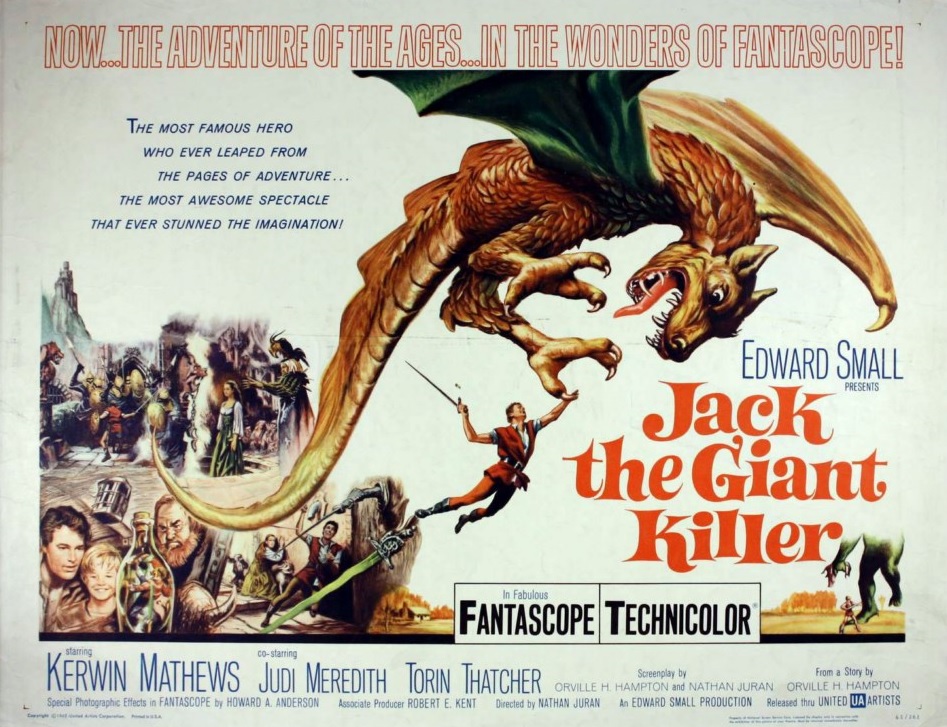
Though it did have a pretty great poster.
The movie begins with an opening that should be familiar to Disney fans – a big bejeweled storybook setting up the tale we are about to experience – from which we learn of an evil sorcerer named Pendragon, who rules over an army of giants, witches and hobgoblins, and whose reign of terror was stopped by the great wizard Herla. The Black Prince (Pendragon’s nom de plume) and his minions were then exiled to a land beyond the known world — I'm guessing Ireland — a place where Pendragon could scheme and wait for his eventual return to power in Cornwall.
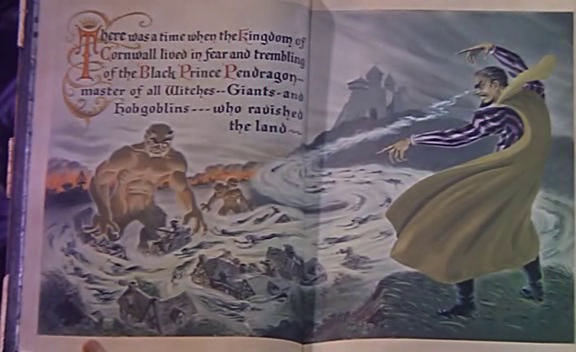
“Once upon a time there was a well-dressed sorcerer.”
Myth Note: The Cornish folklore of “Jack the Giant Killer” regales us with tales of a young farmer named Jack whose exploits under the rule of King Arthur pitted him against a variety of giants, and after killing many of them – to the point that the species must have been on the brink of extinction – Jack was given a seat at the famous Round Table.
Now in the case of Edward Small’s
Jack the Giant Killer, we are introduced to Jack as he kills a giant – saving a lovely princess in the process – but that is the only giant he kills in the film’s 94 minute running time; we do get a second giant, but it's killed by a sea monster and not Jack. Even though this makes the film's title technically accurate – as he does kill a giant – it’s a little bit of a letdown in that area, nonetheless. Another strange choice was in giving the villain the name Pendragon, as that name is most commonly associated with King Arthur’s lineage, but as Pendragon is a title given to an ancient British or Welsh prince — one holding or claiming supreme power — we can understand our “Black Prince” taking that name.
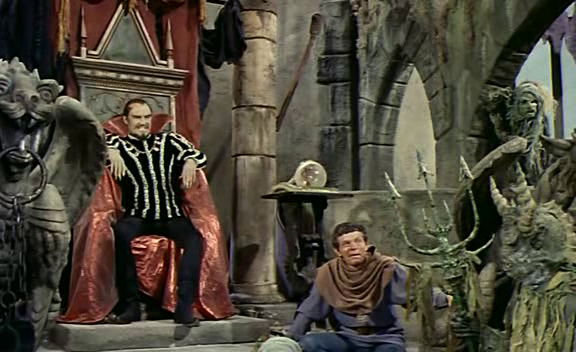
The Black Prince seen here kicking it back in his crib.
The movie of
Jack the Giant Killer – directed by
Nathan Juran, who also directed
The 7th Voyage of Sinbad – follows the adventures of a dashing farmer named Jack (
Kerwin Mathews), who upon saving the lovely Princess Elaine (
Judi Meredith), promptly falls in love with her. He soon finds himself battling the many minions of Pendragon (
Torin Thatcher) for the fair lady's hand. The Black Prince's plan is to rule Cornwall with the Princess as his puppet — forcing her father to abdicate to ensure her safety — and this makes Pendragon a perfect example of the type of villain who tends to make overly elaborate plans, ones that seem doomed from the outset. His first attempt at a hostile takeover involved posing as a visiting prince at Princess Elaine’s birthday — where he gifts her with a magical music box — and said music box happens to contain a small anthropomorphic jester that would, later that night, release its contents and transform into a giant that would then make off with the Princess.
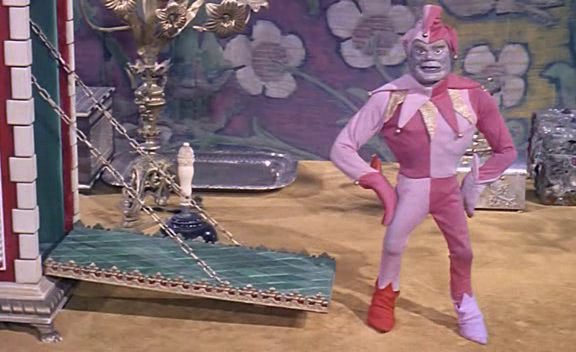
Ingenious plan, but it relies on a woman letting that thing in her bedroom.
This is when the film really starts to dip into the familiar waters of
The 7th Voyage of Sinbad, as not only is Jack being played by the same actor who played Sinbad, and the wizard Pendragon is being played by the actor who played the magician Sokurah in that film, but the first giant we encounter is a blatant rip-off of the cyclops from Ray Harryhausen’s film.
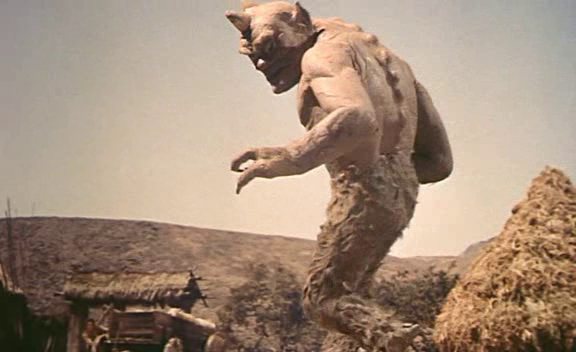
The giant from Jack the Giant Slayer.
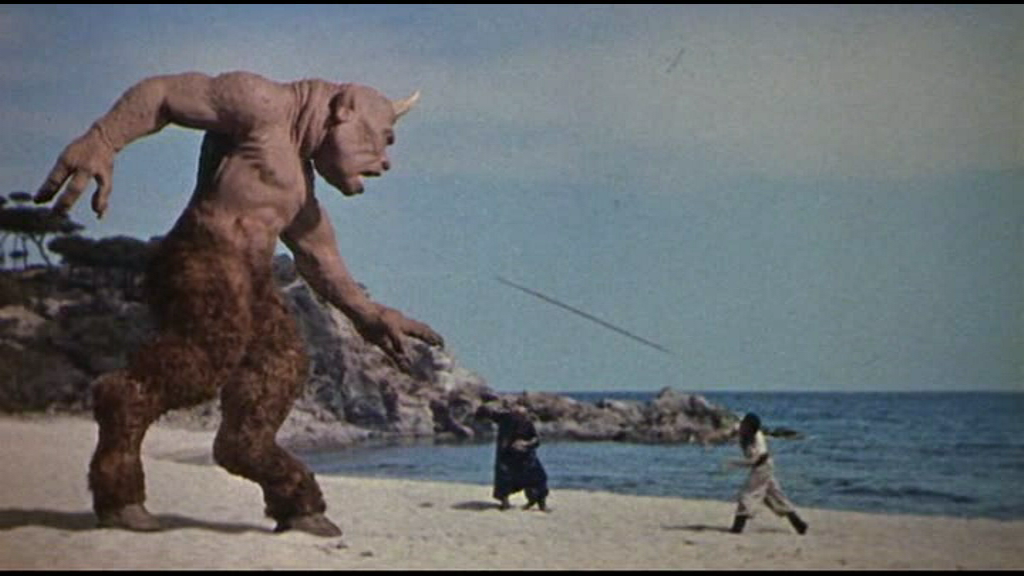
The giant cyclops from The 7th Voyage of Sinbad.
What is worse is that not only was it a pale imitation of the creature Harryhausen created for his film, but it also had none of the personality you'd get from one of Ray's creations. The models in this film — sculpted by effects man
Wah Chang — using cannibalized armatures designed by the great
Marcel Delgado, are rubberl-ike and goofy looking, and they never come close to looking like anything other than what they are, table top toys. Stop-motion animators
Tom Holland and
Jim Danforth did their best with what the sculpts would allow — which wasn’t much — but it’s clear that the producers were looking for more kid-friendly monsters, ones that wouldn't freak out the younger audience members. However, on the complete flip side of this, we meet several frightening ghosts, hobgoblins and witches that appear throughout the film that are batshit crazy, and I’m talking truly horrifying creatures. None of them even remotely family friendly.

Pure nightmare fuel.
When Elaine is kidnapped a second time – by glowing spectral ghosts that look borrowed from Disney’s
Darby O’Gill and the Little People – our hero Jack teams up with a young cabin boy (
Roger Mobley) and a Viking named Sigurd (
Barry Kelley), who just so happens to have an Imp (
Don Beddoe) in a bottle — a leprechaun with three remaining magic coins that can grant wishes — and with their aid, Jack storms Pendragon’s island fortress to save his princess. Once again, fans of
The 7th Voyage of Sinbad will recognize this wish-giving imp as a blatant lift of the genie who aided Sinbad in his fight against the magic of the evil Sokurah. The outright theft on display here is staggering – that Harryhausen and Sinbad producer Charles Schneer didn’t sue this production was a testament to their confidence in the superiority of their own film – yet the list of stolen moments don’t end there. The big action packed finale in
Jack the Giant Killer pits one of Pendragon’s giants against a sea monster, conjured up by the Imp — though calling either of these creatures a monster is being overly kind — but the similarities to the final fight in
The 7th Voyage of Sinbad is undeniable.
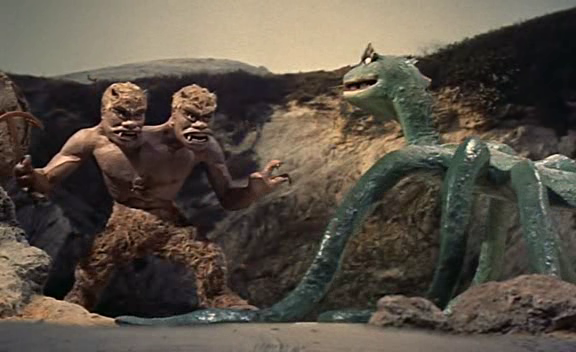
Monster fight in Jack the Giant Killer.

Monster fight in The 7th Voyage of Sinbad.
Though the monster fights in this movie were less than thrilling — and could fairly be called
The Battle of the Adorables — there is one stand-out element in
Jack the Giant Killer that makes the film quite memorable, and that would be when Pendragon transforms Princess Elaine into “Evil Elaine” – a kind of "witch possession" thing that is never fully explained – but the result was that we the audience were treated to what I call “Hot Evil,” and actress Judi Meredith really rocked the hell out of her witch make-up and serpent contact lenses that they gave her. This scene left me wondering if Ridley Scott was influenced by it when he made his fantasy film
Legend, as there is a moment in that film where Darkness (
Tim Curry) transforms Princess Lili (
Mia Sara) into an evil version of herself. Fun monster moments aside it was these scenes with the treacherous Evil Elaine that stuck with me as a kid.

The beauty of evil.
Though this movie is very derivative – even at one point lifting the disembodied torch-carrying arms from Cocteau's
La Belle et La Bête – it is still quite an entertaining film, especially if you haven’t seen all the original source material that producer Edward Small stole from. It has a dashing hero, a beautiful princess, colourful monsters and a truly villainous sorcerer, all adding up to a fun fantasy adventure film. If you first saw this movie as a child, sitting in a crowded kiddie matinee on a hot Saturday afternoon, then there will always be a soft spot for
Jack the Giant Killer.
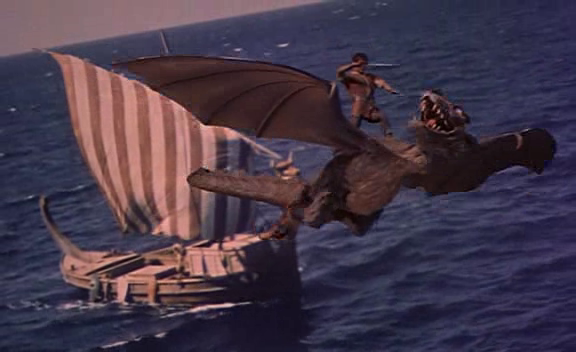
All hail, Jack the Giant killer, and whatever the hell that thing was.












No comments:
Post a Comment